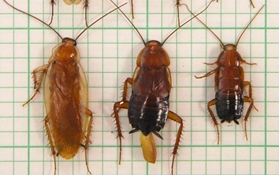Cockroach pheromone discovery may help endangered woodpecker
The discovery, announced this month in the Proceedings of the National Academy of Sciences, may generate better conservation efforts for the imperiled woodpecker and may lead to far-reaching benefits in controlling cockroaches in urban environments, said Coby Schal, the Blanton J. Whitmire Professor of Entomology at North Carolina State University.
The scientific team characterized and synthesized the “mating scent” that the flightless female broad wood cockroach, Parcoblatta lata, releases to attract suitors. Only the males fly; the females live beneath decaying logs in the pine forests of southeastern United States.
The red-cockaded woodpecker, Picoides borealis, lives in old-growth pine forests, excavating nesting sites in large-diameter trees. Native to the southeastern United States, its population has now dwindled to 1 percent of its original population and it is extinct in at least three states, New Jersey, Maryland and Missouri. It is especially sensitive to habitat disturbances and loss of its main food supply. The broad wood cockroach constitutes more than 50 percent of its diet.
Because the cockroach pheromone attracts large numbers of male suitors – all males excellent flyers – the research should help determine whether there is enough woodpecker food in a given area.
"Besides serving as the main diet of the endangered woodpeckers, the adult male cockroaches occasionally infest houses after being attracted to porch lights and the flightless females and nymphs are brought into homes with firewood," Schal said. The synthetic compound could be used to deter cockroach populations.
Hailing the research as helping an endangered species, Leal pointed out that the newly identified sex pheromone may be used “to monitor the quality and suitability of foraging habitat of the red-cockaded woodpecker.”
“Most pheromones and compounds involved in insect chemical communication can be used as environmentally friendly tools for monitoring and controlling populations of agricultural pests and insects of medical importance,” Leal said. “I was particularly thrilled collaborating with my friend Coby Schal to identify this cockroach sex pheromone not only because the chemical structure was unusual and challenging, but also given the potential applications of this green chemical in conservation biology.”
Schal said that the synthetic version of the pheromone attracted a few other Parcoblatta species. It did not attract the Parcoblatta pennsylvanica. Because the compound attracted some Parcoblatta species and not others, this “tells us something about their evolutionary history,” Schal said. While Parcoblatta cockroaches are endemic to North America, the more commonly known pest cockroaches were introduced here from other countries.
The newly discovered pheromone is nicknamed “parcoblattalactone.” It is a previously unknown pheromonal structure, but one which “highlights the great chemical diversity that characterizes olfactory communication in cockroaches,” the scientists wrote in their abstract.
In addition to Schal and Leal, the co-authors of the PNAS paper were Dorit Eliyahu, Satoshi Nojima and Cesar Gemeno, all former members of Schal’s lab; Richard Santangelo, a NC State research specialist; and Shannon Carpenter, Frances Webster and David Kiemle of the State University of New York.
The research was funded by the Blanton J. Whitmire Endowment at NC State.


Posted by Anonymous on June 26, 2016 at 4:44 PM